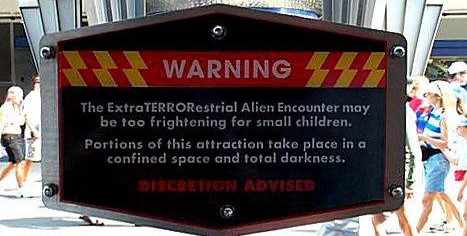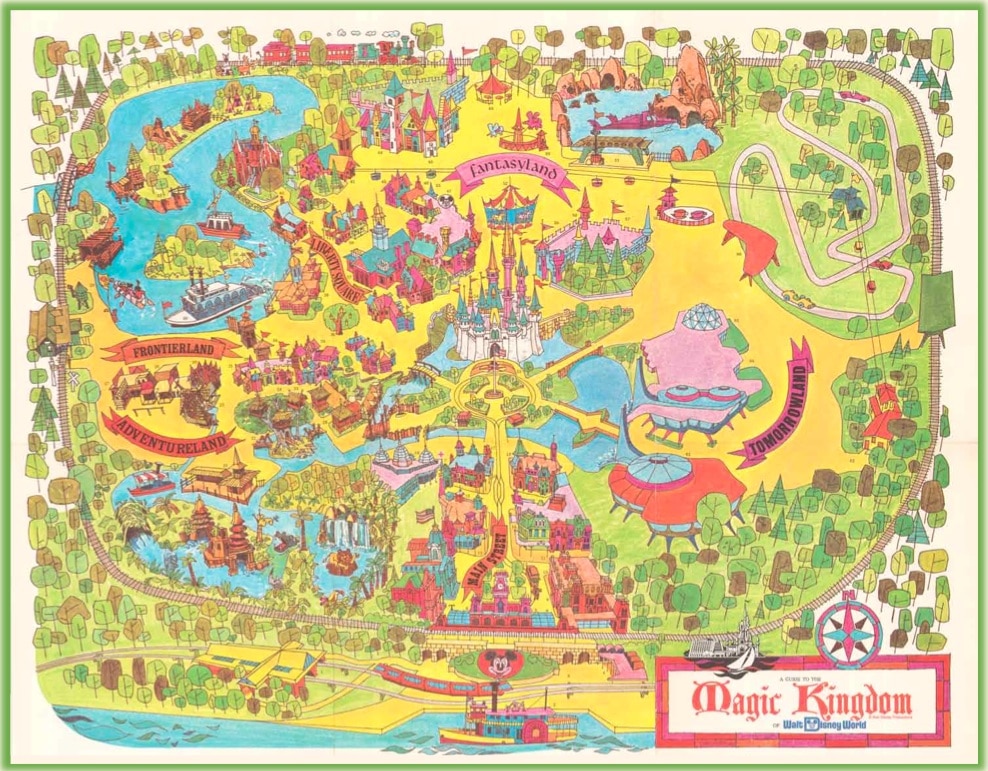Category — A Friday Visit with Jim Korkis
A Friday Visit with Jim Korkis: CommuniCore at Epcot
Welcome back to Fridays with Jim Korkis! Jim, the dean of Disney historians, writes about Walt Disney World history every Friday on yourfirstvisit.net.
COMMUNICORE
By Jim Korkis
Some of the announced changes for Epcot have been cancelled or will be delayed because of the losses of the 2020 closure of the parks.
Epcot has always been a park of things changing, including the disappearance of CommuniCore that debuted with the park in 1982.
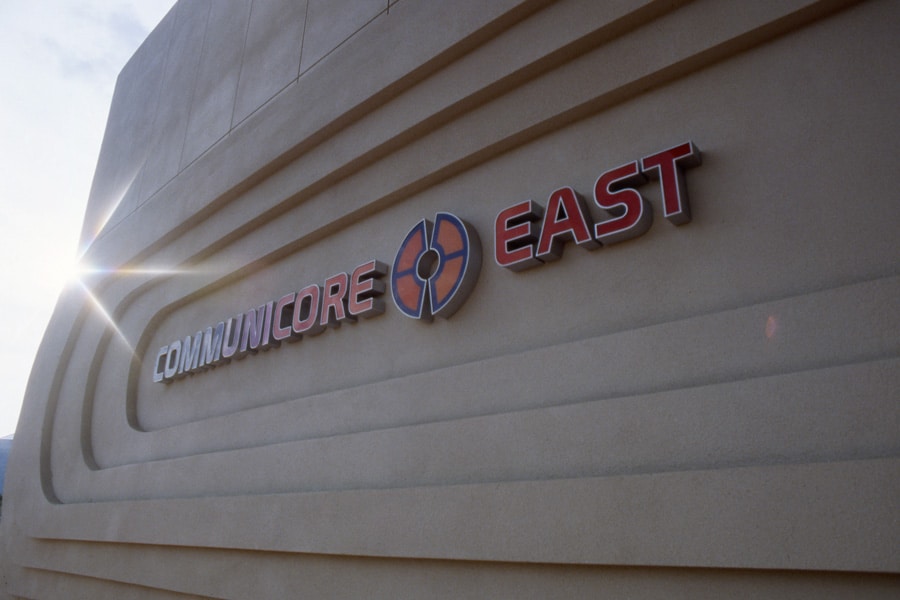
(c) Disney
Disney described CommuniCore as “Future World’s global Main Street of ideas and inventions”. CommuniCore was located in two crescent-shaped, 100,000 square foot buildings (CommuniCore East and CommuniCore West) that faced a large fountain just beyond Spaceship Earth.
The name was a combination of the words “core” and “community,” not “communication” as many Disney guests believed. CommuniCore was meant to provide guests with an introduction and more information about the park’s major themes in a somewhat tranquil setting.
It was supposed to embody Walt Disney’s original plan for Epcot to be a community. The logo for CommuniCore was two crescent shapes facing each other divided into north and south quadrants.
The buildings housed rotating exhibits related to technology, and were replaced in 1994 by Innoventions which was a combination of the words “innovation” and “inventions”. The new area was louder and flashier with more upscale corporate-sponsored exhibits.
CommuniCore had a central, tall, winding corridor that ran though each of the buildings from end to end, with a number of entry/exit points to the outside.
CommuniCore officially included the largest shop in Epcot, the two-story 13,000 square foot Centorium (an Emporium for the 21st Century). It also included two restaurants, the Stargate Restaurant (that later became the Electric Umbrella) and Sunrise Terrace Restaurant (that later became Pasta Piazza and then Fountainview Expresso & Bakery) that were both open for breakfast, lunch and dinner.
CommuniCore East showcased the Astuter Computer Revue (later Backstage Magic) demonstrating the use of computers at the park, and SMRT-1 (Smart One), a purple and chrome robot sitting on a revolving pedestal surrounded by telephones who played games using voice recognition technology with the guests–both exhibits sponsored by Sperry/UNISYS; Compute-A-Coaster where guests could assemble their own roller coaster on a video screen with assistance from an animated beaver; American Express’ Travelport, a fourteen foot red sphere showing different vacation destinations as well as a Travel Service desk to make plans for a trip; Exxon’s Energy Exchange with games, demonstrations, films and interactive experiences like generating enough electricity for a light bulb and getting the optimum gas mileage from a car; and the Electronic Forum which had the Future Choice Theater registering guests’ opinions on a variety of topics.
CommuniCore West showcased a communications themed area sponsored by AT&T called FutureCom that predicted services that would later be provided by the internet; ExpoRobotics with exhibits on precision maneuvering like painting by industrial robot arms was first on display at the 1985 International Science Exposition in Takuba, Japan but purchased from the manufacturers by WDW; the EPCOT Discovery Center, a research center all about E.P.C.O.T. Center and Walt Disney World (later called “Ask EPCOT” and finally EPCOT Outreach); and a Teacher Center.
CommuniCore was packed with many other displays including the Population clock that displayed the rough population of the Earth and changed with every passing second, as well as the Manufactory where guests could assemble an American flag.
Just outside of CommuniCore were the WorldKey Information System kiosks, a digital information system created specifically for Epcot by Bell Laboratories and Western Electric. The main station was in the post-show area outside of Spaceship Earth until 1994. By accessing the touch screen, guests could learn about different attractions and connect with Guest Relations cast members via closed circuit video for assistance or making dining reservations.
Actor Dallas McKennon, known for providing the old prospector safety spiel on Big Thunder Mountain Railroad and the voice of Benjamin Franklin in the American Adventure, provided the host voice for the kiosks.
* * * * *
Thanks, Jim! More on CommuniCore is on the Disney Parks Blog here.
And come back next Friday for more from Jim Korkis!
In the meantime, check out his books, including his latest, Disney Never Lands, about planned but unbuilt concepts, and Secret Stories of Walt Disney World: Things You Never You Never Knew, which reprints much material first written for this site, all published by Theme Park Press.
Follow yourfirstvisit.net on Facebook or Twitter or Pinterest!!
September 11, 2020 No Comments
A Friday Visit with Jim Korkis: Mr. Toad’s Wild Ride
Welcome back to Fridays with Jim Korkis! Jim, the dean of Disney historians, writes about Walt Disney World history every Friday on yourfirstvisit.net.
MR. TOAD’S WILD RIDE AT MAGIC KINGDOM
By Jim Korkis
With Halloween right around the corner, some Disney fans may have forgotten that the original release of the classic The Legend of Sleepy Hollow was paired with another segment about a popular British character.
Mr. Toad’s Wild Ride was a classic “C Ticket” dark ride in Fantasyland that originated at Disneyland on opening day. Its doppelganger was also an opening day attraction at Magic Kingdom’s Fantasyland, but it closed in 1998 and was replaced by The Many Adventures of Winnie the Pooh, despite guest protests.
Mr. Toad’s Wild Ride’s story was a very loose adaptation from the Disney animated feature The Adventures of Ichabod and Mr. Toad (1949) focused primarily on Toad’s terrifying and irresponsible driving through London going “nowhere in particular”.
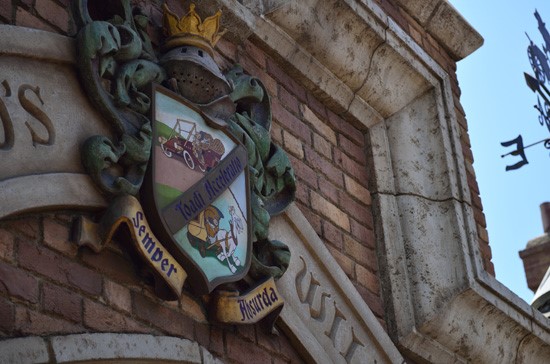
(c) Disney
The Latin motto on Mr. Toad’s coat of arms is “Toadi Acceleratio Semper Absurda” (A Speeding Toad is Always Absurd).
Guests boarded turn-of-the-last century motorcars individually named for characters in the story. Each vehicle had a quarter horsepower electrical motor drawing power from the rail beneath it.
The Disneyland version was so highly popular that the Imagineers wanted to increase the capacity for the attraction, so unlike the California ride, the Florida ride had two separate tracks and boarding areas. Each track featured some different scenes.
Track One took guests through a library, a rural English barnyard with animals, a courtroom and jail cells with convicts. Track Two allowed guests to view Toad’s trophy room, a kitchen, a gypsy camp, Ratty’s house and Winky’s Tavern.
Both tracks took a spin through the town’s plaza, circling a fountain and eventually ended on railroad tracks where an approaching train sends the vehicle to “Hell”. The guests are greeted by gleeful, little red demons having pitchforks and tails, which was a scene not in the film itself but was included because of Walt Disney’s personal feeling that reckless driving should have consequences. Officially, the scene was labeled the “Inferno Room” referencing Dante’s Inferno.
Maintenance costs were minimal. The attraction could accommodate all ages, sizes, and any health conditions. In addition, the attraction was what was known as a “push-button” ride that could be operated by any Fantasyland attraction cast member with minimal training. However, it was a slow loading attraction and the effects quickly became out-dated.
Winnie the Pooh and his friends were enjoying a huge surge of popularity while guests did not remember the film inspiration for the Mr. Toad attraction at all and there was no Toad merchandise being sold in the park. On the other hand, Pooh related merchandise was selling more than Mickey Mouse and with the addition of an attraction those sales would only increase. With the Toad’s attraction double space there was plenty of room for an attraction and a gift shop. In 1997, Disney announced that a Pooh attraction would replace Toad.
A fan campaign was launched to “Save Toad” headed by John Lefante who urged sending letters and e-mails to the Walt Disney Company by the thousands. That campaign led to actual demonstrations at the attraction called “Toad-Ins” reminiscent of the well-known “sit-ins,” and they garnered media attention. Those reports led to even more supporters, but the attraction still closed as announced.
In the new attraction on the left wall of the scene in Owl’s house, there is a painting of Mr. Toad handing over the deed to the building to Owl and there is also a picture of Mole tipping his hat to Pooh. In the Haunted Mansion pet cemetery, up near the top is the Kevin Kidney Big Fig of Mr. Toad painted to resemble an oxidized, rusting grave marker.
Disneyland Paris was originally meant to have a ride version that would have been truer to the actual film with a different final scene that would have had Toad in a plane. It was never built but a Toad Hall restaurant (with an exterior similar to Disneyland’s revised 1983 attraction) did open.
* * * * *
Thanks, Jim! And come back next Friday for more from Jim Korkis!
In the meantime, check out his books, including his latest, Disney Never Lands, about planned but unbuilt concepts, and Secret Stories of Walt Disney World: Things You Never You Never Knew, which reprints much material first written for this site, all published by Theme Park Press.
Follow yourfirstvisit.net on Facebook or Twitter or Pinterest!!
September 4, 2020 No Comments
A Friday Visit with Jim Korkis: Splash Mountain
Welcome back to Fridays with Jim Korkis! Jim, the dean of Disney historians, writes about Walt Disney World history every Friday on yourfirstvisit.net.
SPLASH MOUNTAIN AND THE PRINCESS AND THE FROG
By Jim Korkis
Many Disney fans, myself included, were taken completely by surprise when the Walt Disney Company announced in June that it would be re-theming Splash Mountain to the animated feature film The Princess and the Frog (2009).
Splash Mountain opened at Disneyland on July 17, 1989 and three years later on July 17, 1992 at Walt Disney World’s Magic Kingdom. It opened at Tokyo Disneyland that same year.
There are some differences among the three in terms of duration, length of flume, and number of drops, although all three tell the same story in a fairly identical layout.
Splash Mountain was created at Disneyland for three business reasons. First, Executive Vice President (basically head of Disney Parks and Resorts) Dick Nunis wanted a water flume ride at the park. Second, a big attraction was needed to draw more attendance to the dead end cul-de-sac known as Bear Country. Third, the America Sings attraction was closing, and this was an opportunity to re-use the audio-animatronics.
It was Imagineer Tony Baxter who found the solution to all three challenges and came up with the idea that it could all be themed to the Disney feature film Song of the South (1946), especially since the audio-animatronics characters had been designed by Marc Davis who had animated similar characters for the problematic film.
Several names were suggested for the attraction including “Song of the South Log Flume Ride”, “Zip-a-Dee-Doo-Dah”, and “Zip-a-Dee River Run.” At one point, CEO Michael Eisner looked at the model and said, “It’s a mountain… you have a big splash at the end… it’s Splash Mountain.”
At Eisner’s insistence, Uncle Remus would not be shown or mentioned in the attraction, for fear of possible controversy. In fact, the ride would just reflect the three animated segments in the film and ignore the live action story and characters.
The attraction loosely follows some of the incidents in the animated sections of the Song of the South film. Brer Rabbit runs away from home and finds himself in more adventures than he intended. He continually outwits Brer Fox and Brer Bear until he is trapped in honey (rather than the politically incorrect Tar Baby in the movie) and taken to Brer Fox’s lair to be eaten.
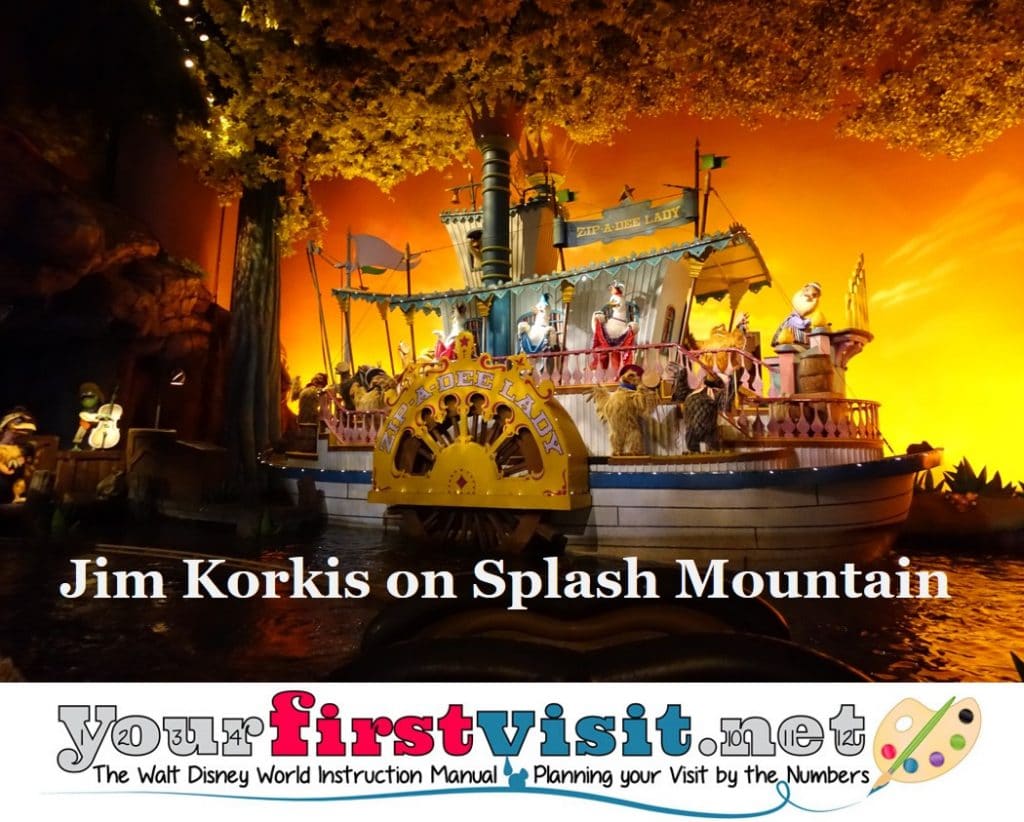
At Walt Disney World, the project was turned over to an entirely different team of Imagineers led by Eric Jacobson. There had to be some significant exterior color changes to blend into the Frontierland color scheme (rather than the Georgia-looking red coloring at Disneyland). The ride and the queue are both longer at Magic Kingdom than at Disneyland.
At Walt Disney World, there is a stronger presence of Brer Frog (Uncle Remus’ fishing buddy in the original movie) as a storyteller. The ride vehicles were designed so that guests could ride side-by-side rather than Disneyland’s sitting in a single file like the original Matterhorn bobsleds.
There are significantly more audio-animatronics characters in the Disneyland version because they were rescued from America Sings. In Florida, there are fewer such figures because they were expensive to build.
My favorite Florida addition is the weasel located in the cavern scene, the last scene before the water log reaches the incline for the big drop. He pops out of the ceiling when the water log is approaching Brer Fox and Brer Rabbit,
He shouts “FSU” (Florida State University), although is sounds somewhat like a sneeze, because one of the Imagineers was a graduate of that school. Interestingly, this character was also included in the Tokyo Disneyland version.
For now, the attraction remains open and will probably continue to operate for awhile because of the pandemic.
* * * * *
Thanks, Jim! Find more from Jim on the history of this in his Who’s Afraid of The Song of the South?.
And come back next Friday for more from Jim Korkis!
In the meantime, check out his other books, including his latest, Disney Never Lands, and about planned but unbuilt concepts, and Secret Stories of Walt Disney World: Things You Never You Never Knew, which reprints much material first written for this site, all published by Theme Park Press.
Follow yourfirstvisit.net on Facebook or Twitter or Pinterest!!
August 28, 2020 No Comments
A Friday Visit with Jim Korkis: The Complete WDW Fun Finds
Welcome back to Fridays with Jim Korkis! Jim, the dean of Disney historians, writes about Walt Disney World history every Friday on yourfirstvisit.net.
YOUR PERSONAL DISNEY LIBRARY (31)
By Jim Korkis
- The Complete Walt Disney World Fun Finds & Hidden Mickeys by Julie and Mike Neal
I have always been a huge fan of the nooks and crannies of Walt Disney World and have attempted to document many of them in my books. I also realize that the rich detail is so immersive that I don’t always spot something, so I am always interested in books that claim they will reveal some of those things that I may have missed.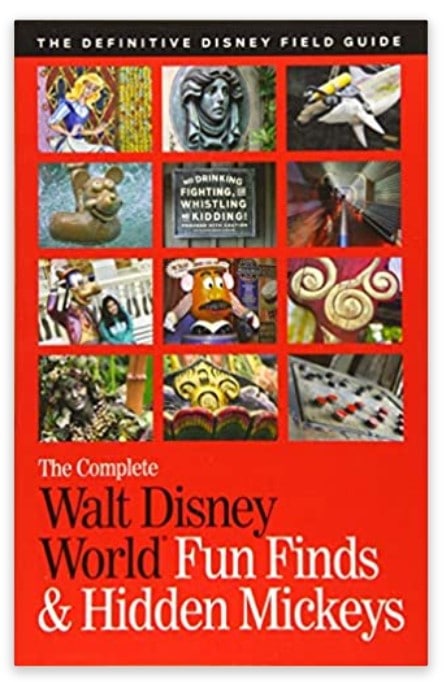
In addition, I found the material accurate although there were occasions where the entire story was not shared either because of space limitations or simply not being aware of the rest of the story.
With hundreds and hundreds of short “fun finds”, I found myself continually surprised and delighted. My only disappointment is that not every fun find was accompanied by a photograph reference although many were. Almost every page is filled with multiple color pictures, so it is hard to complain.
The Neals describe a “fun find” as “little details – in-jokes, props, sight gags, story elements and tributes that appear right in front of you but that you’re not really supposed to see” because it blends in so seamlessly to the environment or your attentions is diverted elsewhere.
I am assuming that the Neals also included Hidden Mickeys in an attempt to help sell more books since the hunt for such things is a huge obsession for some Disney fans. While they do a good job documenting many of these sightings, if you are deeply interested in Hidden Mickeys, you should be buying Steve Barrett’s fine books.
Some have complained that a large portion of the book is devoted solely to the Haunted Mansion (roughly 40 of the book’s 250 pages) while other things may have been ignored, but I did not feel that was a disadvantage. I am a fan of the attraction and enjoyed seeing the newer items that had been added to the queue documented very well. However, I can understand why some readers might only have a casual interest in the attraction and feel disappointed that so much space was devoted to it.
Julie was a former WDW concierge supervisor and focuses on the text which is clear and concise. Her husband Mike is a professional photographer with a good eye for capturing not only a nice composition but also the valuable information of the item being photographed (rather than some “artsy” interpretation that obscured the information). In this book, they were helped by their daughter Micaela, who apparently helped with the Haunted Mansion section in particular.
I don’t believe that Julie and Mike Neal have published a new edition of The Complete Walt Disney World travel guide since their tenth anniversary edition that was released in 2016 to cover 2017. What made their guidebook particularly stand out for me were all the outstanding full color photographs by Mike.
As I have pointed out before, if you are interested in Disney history rather than current planning for a trip, picking up copies of older guidebooks will supply a wealth of valuable information. In this particular case, older editions of the work of the Neals will also supply a plethora of beautiful reference photos as well.
Although published in 2015, much of the Fun Finds & Hidden Mickeys remain current and I am glad to have a copy in my collection.
* * * * *
Thanks, Jim! And come back next Friday for more from Jim Korkis!
In the meantime, check out his books, including his latest, Disney Never Lands, and about planned but unbuilt concepts, and Secret Stories of Walt Disney World: Things You Never You Never Knew, which reprints much material first written for this site, all published by Theme Park Press.
Follow yourfirstvisit.net on Facebook or Twitter or Pinterest!!
August 21, 2020 No Comments
A Friday Visit with Jim Korkis: ExtraTERRORestrial at Magic Kingdom
Welcome back to Fridays with Jim Korkis! Jim, the dean of Disney historians, writes about Walt Disney World history every Friday on yourfirstvisit.net.
EXTRATERRORESTRIAL ALIEN ENCOUNTER
By Jim Korkis
ExtraTERRORestrial Alien Encounter opened in Tomorrowland in June 1995, replacing the Mission to Mars attraction. It was originally intended as an attraction for the never produced Tomorrowland 2055 make-over at Disneyland, and would have been based on the Alien movie franchise that began in 1979.
Filmmaker George Lucas was brought in to work on the concept and abandoned any connection to the Alien movie franchise because it was determined to be too traumatic and intense for Disney guests.
Despite the word “terror” being in all capital letters as the name of the attraction and the many warning signs that stated that it was “ a frightening theatrical experience in a confined setting with loud noises and moments of total darkness (that) may be too intense for children and some adults,” many guests were still unprepared for the experience that was presented, and there were complaints.
Guests entered the Tomorrowland Interplanetary Convention Center to witness a demonstration of the alien corporation X-S Tech’s latest technological innovation. The lobby show music consisted of twelve original musical selections composed specifically for the attraction by George Wilkins, as well as posters and videos that humorously referenced Disney related science-fiction efforts including “Lunar Disneyland. The Happiest Place Off Earth.”
Chairman L.C. Clench (played by actor Jeffrey Jones) was excited to find a new world to sell his products, and told the guests, “If something can’t be done with X-S [Excess], then it shouldn’t be done at all!”
In the pre-show, the amoral robot S.I.R. (Simulated Intelligence Robotics), voiced by Tim Curry, gave a disturbing demonstration of the newest Series 1000 teleportation device as he transported the adorable alien Skippy across the room where he reappeared burned, in pain, scared, and confused.
Guests proceeded to an amphitheater Testing Center of concentric circles of seating surrounding a large cylindrical teleportation tube similar to the one they had just seen in the pre-show. For “safety reasons,” each seat included gigantic over the shoulder harnesses that locked down on each guest.
Binaural audio like the breathing of the alien would be pumped through two special speakers located next to each ear along with warm, moist water (to simulate the creature’s drool and the blood of a killed technician and exploded alien) and hot air effects (to simulate the creature’s tongue licking the guest’s head). The feeling of being restrained added to the anxiety of being in the dark.
Clench decides to use the device to teleport himself to the audience but something in the signal path intercepts the transmission. What appears in the tube is not Clench but an extraterrestrial that is tall with spider-like legs, gnashing fangs, glowing red eyes and transparent wings. It is determined to be carnivorous.
It crashes through the tube and the theater goes dark and the audience imagines this creature right behind them. The alien is lured back into the tube and exploded.
The attraction closed in 2003 and was replaced by a similar but more comical and family-friendly attraction called Stitch’s Great Escape in 2004. The Interplanetary Convention Center was recast as the Galactic Federation Prisoner Transport Center, with guests recruited as trainees in the cosmic government’s justice system and witnessing the arrival of a Level 3 prisoner, Stitch, who escapes into the Walt Disney World park.
Stitch attraction went to seasonal only operation in 2016 and it was announced in July that it would be closed permanently. Papers have already been filed for its demolition. There has been no formal announcement of what might replace it.
* * * * *
Thanks, Jim! And come back next Friday for more from Jim Korkis!
In the meantime, check out his books, including his latest, Disney Never Lands, and about planned but unbuilt concepts, and Secret Stories of Walt Disney World: Things You Never You Never Knew, which reprints much material first written for this site, all published by Theme Park Press.
Follow yourfirstvisit.net on Facebook or Twitter or Pinterest!!
August 14, 2020 No Comments
A Friday Visit with Jim Korkis: Magic Kingdom Skyway
Welcome back to Fridays with Jim Korkis! Jim, the dean of Disney historians, writes about Walt Disney World history every Friday on yourfirstvisit.net.
MAGIC KINGDOM SKYWAY
By Jim Korkis
While Walt Disney World guests have been enjoying the gondola lift system called the Disney Skyliner since it opened in September 2019, Disney fans like myself who are older than they would like to admit clearly remember another such system that operated in the Magic Kingdom.
The Magic Kingdom Skyway was an opening day attraction at Walt Disney World in 1971 that closed in 1999.
Built by Von Roll of Bern, Switzerland, who had provided similar sky rides for over 100 amusement venues, it offered one-way transportation to Fantasyland or Tomorrowland so it was billed as two separate attractions. No round trips were allowed.
Each colorful, open-aired gondola could hold four adults or roughly 700 pounds. Two guests faced forward and two faced backward as the gondolas lifted up and rocked back and forth on overhead cables for less than five minutes.
The gondolas traveled above the main area of Fantasyland and the crystal clear 20,000 Leagues Under the Sea attraction lagoon while providing a wonderful photo opportunity before the vehicles made a sharp right turn near the Tomorrowland Speedway. The journey continued with the gondolas passing Space Mountain before touching down at the Tomorrowland Station.
Guests could even enjoy distant views of the Contemporary Resort, Splash Mountain, and the Grand Floridian Resort and Spa. Pinocchio’s Village Haus was designed so that the view looking down from the gondolas mimicked the opening overhead shot of Gepetto’s village from the animated feature.
In February 1999, a park custodian at Walt Disney World’s Magic Kingdom was killed when the skyway started up expectedly while he was cleaning one of its platforms. Raymond Barlow, 65, was sweeping off a narrow skyway platform inaccessible to park guests an hour after the park’s 9:00 A.M. opening when other cast members, unaware of his presence, started up the ride.
Barlow, startled by the approaching gondola, grabbed onto it and tried to climb inside and fell forty feet into a flower bed, hitting a tree on the way down, and died. The Occupational Safety and Health Administration later ruled that the area in which Barlow had been working violated federal safety codes and fined Walt Disney World $4,500 for a “serious” violation of safety standards
The last day of operation for the attraction was in November 1999, because the cost of operating and maintaining the attraction was high in relation to its hourly capacity as well as the need to upgrade it for disabled access and structural repairs. There were also increasing concerns about liability with guests rocking the gondolas, spitting and throwing things out of them onto the guests walking below.
“It’s part of our ongoing efforts to phase out some of the older attractions and introduce new things to keep our parks exciting for our new and repeat visitors,” Walt Disney World spokesman Diane Ledder told the media. “It’s just something whose time has come.”
When the Fantasyland Station closed, the pylons and wires were removed from the park, but some of the equipment remained in the building. The Bavarian-style Alpine building that featured a large clock still reflected the village theme of the area. The front area was used for stroller parking.
The station was eventually removed and replaced by the Tangled Restrooms as well as a wider path to Liberty Square.
The Tomorrowland Station was two stories high with a waterfall on one side. When it closed, the top half of the building and the waterfall were eventually removed and a bathroom was installed on the ground floor.
The DisneyStyle store at Disney Springs has a blue Skyway gondola hanging from the ceiling just above the Mad Tea Party teacup photo-op.
* * * * *
Thanks, Jim! And come back next Friday for more from Jim Korkis!
In the meantime, check out his books, including his latest, Disney Never Lands, and about planned but unbuilt concepts, and Secret Stories of Walt Disney World: Things You Never You Never Knew, which reprints much material first written for this site, all published by Theme Park Press.
Follow yourfirstvisit.net on Facebook or Twitter or Pinterest!!
August 8, 2020 No Comments



